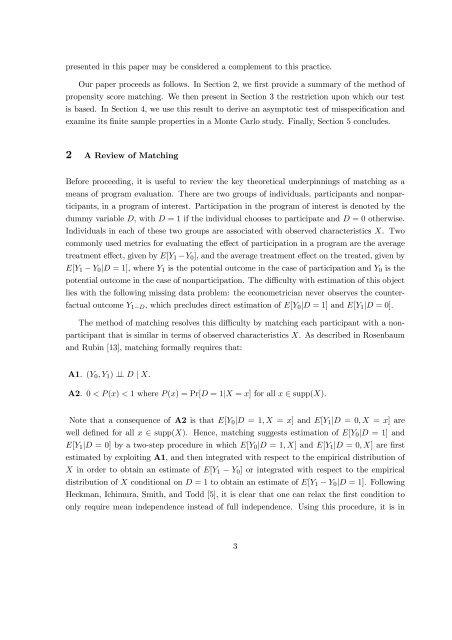On the Identification of Misspecified Propensity Scores - School of ...
On the Identification of Misspecified Propensity Scores - School of ...
On the Identification of Misspecified Propensity Scores - School of ...
You also want an ePaper? Increase the reach of your titles
YUMPU automatically turns print PDFs into web optimized ePapers that Google loves.
presented in this paper may be considered a complement to this practice.<br />
Our paper proceeds as follows. In Section 2, we first provide a summary <strong>of</strong> <strong>the</strong> method <strong>of</strong><br />
propensity score matching. We <strong>the</strong>n present in Section 3 <strong>the</strong> restriction upon which our test<br />
is based. In Section 4, we use this result to derive an asymptotic test <strong>of</strong> misspecification and<br />
examine its finite sample properties in a Monte Carlo study. Finally, Section 5 concludes.<br />
2 A Review <strong>of</strong> Matching<br />
Before proceeding, it is useful to review <strong>the</strong> key <strong>the</strong>oretical underpinnings <strong>of</strong> matching as a<br />
means <strong>of</strong> program evaluation. There are two groups <strong>of</strong> individuals, participants and nonpar-<br />
ticipants, in a program <strong>of</strong> interest. Participation in <strong>the</strong> program <strong>of</strong> interest is denoted by <strong>the</strong><br />
dummy variable D, with D = 1 if <strong>the</strong> individual chooses to participate and D = 0 o<strong>the</strong>rwise.<br />
Individuals in each <strong>of</strong> <strong>the</strong>se two groups are associated with observed characteristics X. Two<br />
commonly used metrics for evaluating <strong>the</strong> effect <strong>of</strong> participation in a program are <strong>the</strong> average<br />
treatment effect, given by E[Y1 −Y0], and <strong>the</strong> average treatment effect on <strong>the</strong> treated, given by<br />
E[Y1 − Y0|D = 1], where Y1 is <strong>the</strong> potential outcome in <strong>the</strong> case <strong>of</strong> participation and Y0 is <strong>the</strong><br />
potential outcome in <strong>the</strong> case <strong>of</strong> nonparticipation. The difficulty with estimation <strong>of</strong> this object<br />
lies with <strong>the</strong> following missing data problem: <strong>the</strong> econometrician never observes <strong>the</strong> counter-<br />
factual outcome Y1−D, which precludes direct estimation <strong>of</strong> E[Y0|D = 1] and E[Y1|D = 0].<br />
The method <strong>of</strong> matching resolves this difficulty by matching each participant with a non-<br />
participant that is similar in terms <strong>of</strong> observed characteristics X. As described in Rosenbaum<br />
and Rubin [13], matching formally requires that:<br />
A1. (Y0, Y1) ⊥ D | X.<br />
A2. 0 < P (x) < 1 where P (x) = Pr[D = 1|X = x] for all x ∈ supp(X).<br />
Note that a consequence <strong>of</strong> A2 is that E[Y0|D = 1, X = x] and E[Y1|D = 0, X = x] are<br />
well defined for all x ∈ supp(X). Hence, matching suggests estimation <strong>of</strong> E[Y0|D = 1] and<br />
E[Y1|D = 0] by a two-step procedure in which E[Y0|D = 1, X] and E[Y1|D = 0, X] are first<br />
estimated by exploiting A1, and <strong>the</strong>n integrated with respect to <strong>the</strong> empirical distribution <strong>of</strong><br />
X in order to obtain an estimate <strong>of</strong> E[Y1 − Y0] or integrated with respect to <strong>the</strong> empirical<br />
distribution <strong>of</strong> X conditional on D = 1 to obtain an estimate <strong>of</strong> E[Y1 − Y0|D = 1]. Following<br />
Heckman, Ichimura, Smith, and Todd [5], it is clear that one can relax <strong>the</strong> first condition to<br />
only require mean independence instead <strong>of</strong> full independence. Using this procedure, it is in<br />
3
















